Easy Coding Things to Do on Chrome Books to Impress Your Freinds

Do you know what this is?
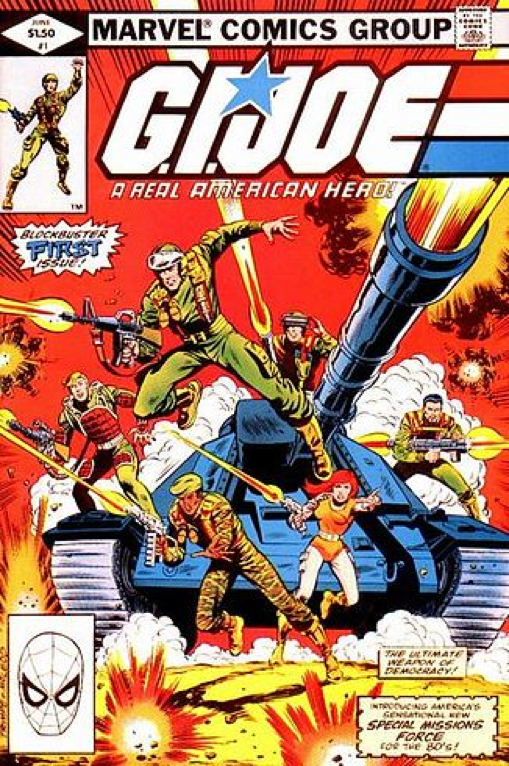
This, my friend, is one of the greatest examples of content marketing of all time.
I bet when you hear "content marketing," you think about blogs, Twitter, Facebook, and viral YouTube videos.
However, content marketing has been around far longer than the Internet.
Sure, it might sound like a new strategy, but the truth is, content marketing is a tried and true method that stands the test of time.
Do you know why it works so well? Because content marketing isn't about selling to people: it's all about storytelling, and humans have been telling stories for as long as they could speak. Naturally, our attention goes to the best storytellers.
For example, when Hasbro and Marvel cooperated to launch their comic book series "G.I. Joe – A Real American Hero!" in 1982, they had a simple marketing strategy.
They wanted to create what Kenner Toy Company's Star Wars action figures already had: A rich backstory for their action figures.
Within two months of releasing the first comic book, about 20% of their target audience, boys between the ages of five and twelve, had two or more G.I. Joe toys. At that point, the comic book only had two stories.
Fast forward seven years, the series was one of Marvel's strongest titles, and two out of three boys in the same age category owned at least one G.I. Joe action figure.
How's that for using content to market a product?
A lot has changed since then, and what worked back in the 80s won't necessarily work today. However, with new marketing channels like social media popping up almost daily, opportunity is knocking.
This brings me to content marketing today. Let's look at what content marketing means now in my detailed guide. Feel free to skip ahead if one topic catches your eye:
- Definition
- Overview
- Strategy
- History
- Why content marketing?
- Content mapping based on the customer journey
- Awareness stage content
- Consideration stage content
- Decision stage content
- Additional forms of content marketing
- Social media
- Live video
- Paid advertising
- A few extra tips and tricks
- Offline
- Online
- Hybrids
Definition of Content Marketing
What is content marketing? The Content Marketing Institute defines content marketing as:
"a strategic marketing approach focused on creating and distributing valuable, relevant and consistent content to attract and retain a clearly-defined audience — and, ultimately, to drive profitable customer action."
Their definition is solid, in my opinion, but it could use some clarity.
Content marketing is a long-term strategy that focuses on building a strong relationship with your target audience by giving them high-quality content that is relevant to them and delivering it consistently. It also means tailoring your content depending on what stage of the buying journey your customer is at. For instance, if you've got a prospect seeking more information, a good content offering would be an eBook or cheatsheet.
Eventually, when customers make a purchase decision, their loyalty already lies with you; they purchase your product and prefer it over competitors' options.
In contrast to one-off advertising, content marketing shows that you actually care about your customers.
Today, more than ever before, people want to feel like they matter. The world is louder and noisier now, and keeping consumers' attention is the marketer's most valuable resource.
Keep that in mind as we look at some of the different types of content marketing.
Content Marketing Overview
When Joe Pulizzi founded the Content Marketing Institute in 2010, I don't think he knew exactly how spot-on he would be, let alone how successful CMI would become.
The Institute is one of the top resources for content marketing statistics, and they've created a great video overview of the evolution of content marketing:
Since the foundation of content marketing is simply high-quality content and storytelling, you can already see that the concept has been around longer than the term itself.
There's still plenty to learn from those first offline content marketing activities that pre-date the Internet, social media, and the like.
However, any successful content marketing campaign today can hardly ignore the online part. Because storytelling has changed over the years, different content styles and approaches get old quick. Make sure you're creating content relevant to the year we actually live in.
There are three major categories where you can put content marketing efforts these days: online, offline, and hybrids.
The best way to learn how to be a great content marketer is by example.
That's why I'll show you some great examples of content marketing in all categories. Then, you can model them, tweak them, and apply them to your own businesses.
First, though, let me show you how you can create a content marketing strategy. Then, you can use the examples at the end for inspiration.
Strategy
Tons of different content marketing strategies exist today. I'm talking about things like social media, long-form articles, videos, and case studies.
At the beginning of the content marketing world, that wasn't the case. At one time, marketers had few options. They essentially only had bandit signs, magazines, and newspaper ads.
Even in those days, however, they had various custom choices.
They could play with the words in their advertisements, the picture they showed, their placement of them, and the CTA.
In other words, although there were fewer content marketing methods, the options were still remarkably vast.
Today, more content marketing mediums and methods exist than ever before. That means that the number of strategies is even greater.
One online publication suggests using the "3D Content" model, for instance.
Basically, it's three individual steps.
- Map the content to the pain point.
- Use the right type of content for that problem.
- Finally, map the content to the buying cycle of the people who have that problem.
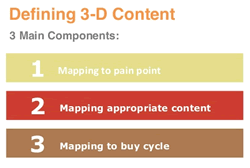
This strategy is a way to move the focus away from the marketer and to the ideal customer, or prospect.
That, after all, is an incredibly important step to take in your own content marketing strategy.
You see, if your content doesn't cater to the right people with the right problem that your product solves, then it's likely you're going to end up wasting your content marketing efforts.
Just to reiterate: You must create content for your target audience. Then, and only then, the right people pay attention to you.
According to the source itself — Content Marketing Institute— here are the tips you should follow when creating a content marketing strategy.
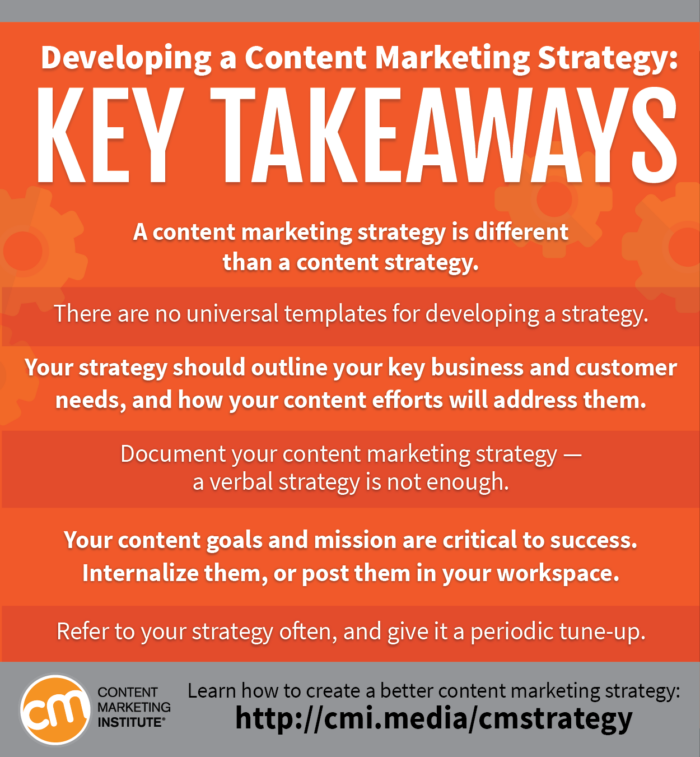
Notice, in particular, this tip: "Your strategy should outline your key business and customer needs, and how your content efforts will address them."
What does that mean?
It means that you must understand your customers, prospects, and pain points. Once you do, you can then create content that solves their problems. In theory, it can then grow your business, which is the main goal for many company owners. However, you can't do that unless you first attract paying customers.
In a world with social media, endless Internet space, self-publishing companies, and free graphic design tools, the strategies you can use to attract paying customers are as varied as the fish in the sea.
Here are just some of the content marketing formats you can use:
- Content curation
- Opinion posts
- White papers
- Q & A's
- E-books
- Newsletters
Alternatively, you could add a new level of creativity with:
- Infographics
- Slideshows
- Online games
- Quizzes and surveys
- Mindmaps
- Memes
- Illustrations
Or you might build authority and create consumer confidence with:
- Webinars
- Behind-the-scenes pieces
- How-tos
- Free tools and downloads
Whatever you want to achieve, you can use content marketing to help you do it.
As you can see, there are a ton of options, but don't get overwhelmed.
You're here to learn about the benefits of each option and when to use which one. While there's only one goal of content marketing (to increase business revenue), there are many ways to do that.
However, before we can jump in and see how you can create your own strategy, you should first understand a bit of content marketing's history.
Where did it come from? Why has it lingered? Why is it so popular today?
We'll turn to those questions next.
History of Content Marketing
How old would you guess that content marketing is?
When someone first asked me that question a few years ago, I thought it had been around for maybe 50, 70, or perhaps even 90 years.
However, I was wrong. Completely wrong.
The year is 1732, and a man named Benjamin Franklin had just published the first version of his annual Poor Richard's Almanack.
Why did he do it? For fun because he liked writing and expressing his ideas?
Nope, I'm pretty sure that wasn't the case.
I'm sure Franklin did it because he wanted to advertise his new printing business. Franklin figured the best way to do this was to print his own Almanack and potentially encourage others to print there, too.
According to Content Marketing Institute's timeline, this is the very first occurrence of true content marketing.

That was almost 300 years ago.
I bet you didn't think that content marketing started with Benjamin Franklin in the 1700s. After all, content marketing feels like a modern development.
However, while the term is fairly new, the practice isn't.
For years, businesses and individuals alike have tried to attract attention by creating free or cheap content.
John Deere, the tractor company, did something similar to Franklin in 1895 when they produced a lifestyle magazine for farmers called "The Furrow."
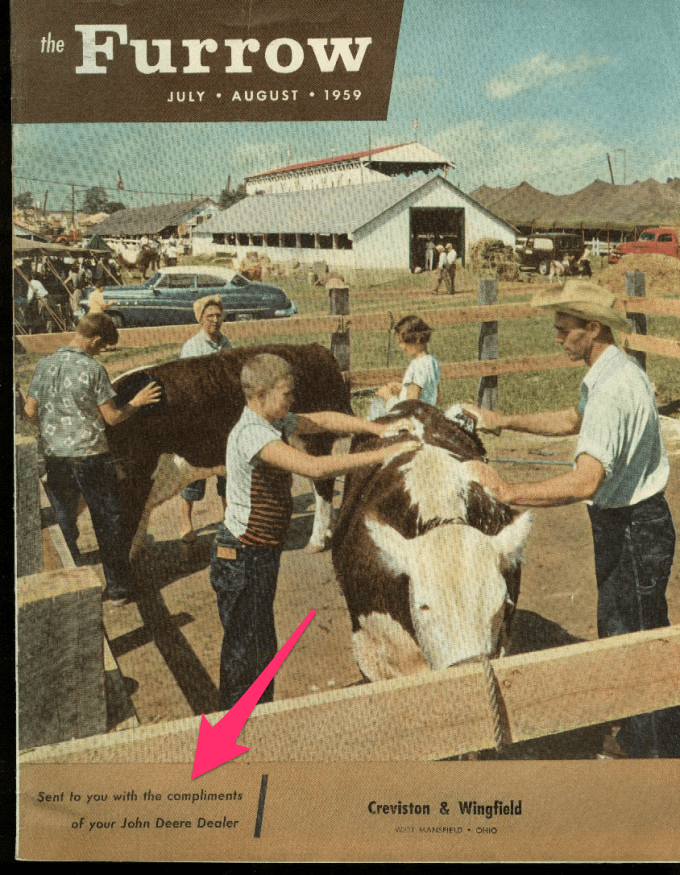
As you can see in the bottom left-hand corner, it was a complimentary magazine.
Now, you could argue that John Deere did this out of the kindness of their hearts. Perhaps they simply wanted to help people and didn't realize the effect that this publication would have on the business's revenue.
More than likely, though, that wasn't the case.
John Deere did this because they understood the heart of content marketing: what goes around comes around.
Or basically, if you produce free and helpful content for your target market, they engage with you, spread your message, and probably even buy from you.
Jell-O also understood the value of content marketing early on in their journey.
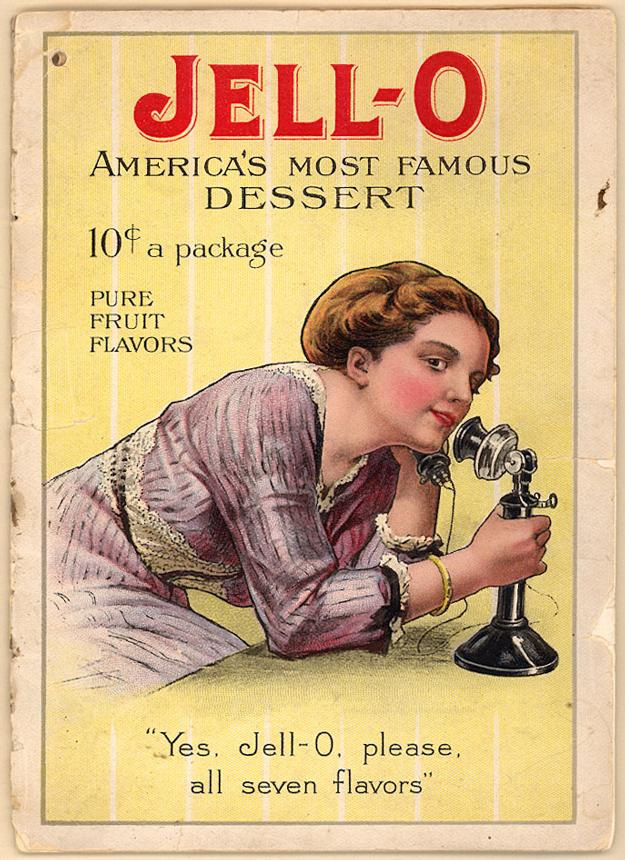
Below is one from Safari Cards that ran for almost 10 years starting in 1978.
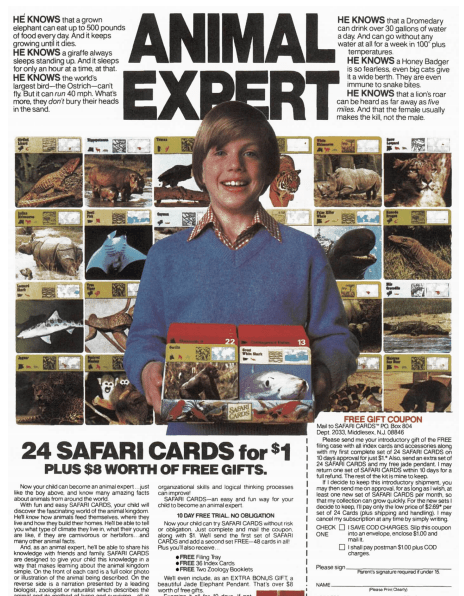
These are clear examples that content marketing has been a part of advertising over the last few hundred years.
Even though the methods for content marketing have changed over the years, the formula for great content has stayed largely the same.
It's the same formula for getting people to buy your products.
- Push on the person's pain point.
- Agitate that pain.
- Solve their problem.
Here's a more modern content marketing ad that implements that same strategy.

Now, of course, this happens in videos and pictures and blog posts and infographics.
As you can see, content marketing has come a long way in the last few centuries.
One shining example of modern content marketing is Blendtec's "Will It Blend?" series on YouTube.
Here's a video where they blend an iPhone. You have to see it to believe it.
Even the Lego Movie series is a content marketing stunt.
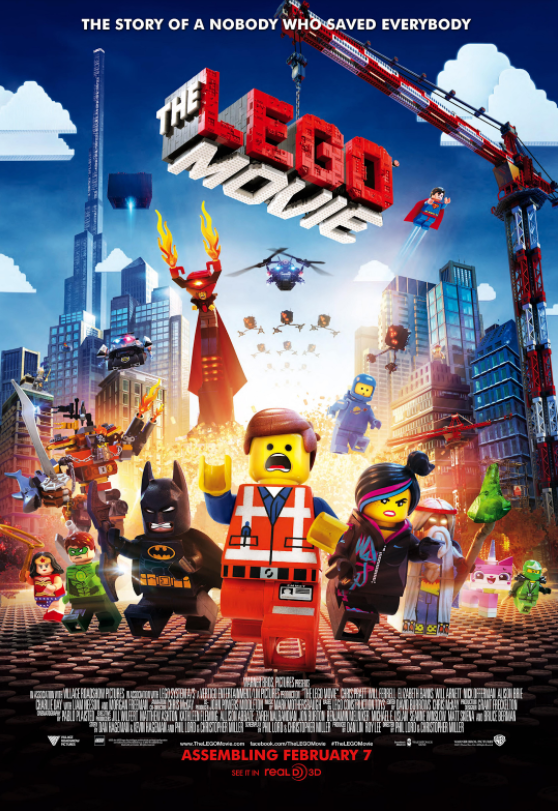
Why do businesses do this kind of content marketing, though?
After all, they aren't outright selling their products. They're generating attention, sure. But does that really matter?
The short answer is yes. In today's world, consumer attention is as good as dollar bills.
However, that's only true if it's the right attention, and content marketing often does a remarkable job of drawing the eyes of people who care about your product and want to buy it.
Why Content Marketing?
OK. Content marketing is popular. Lots of businesses use it, and they've used it for hundreds of years. Is it right for your business, though?
Just because content marketing worked for early adopters, that doesn't mean it's going to work for your modern-day business. Additionally, just because massive B2B and B2C businesses use it today also, that doesn't mean that it's right for you.
To find out, let's take a look at some recent and relevant content marketing data.
In the end, I'll try to answer the question two questions: Is content marketing right for you? And should you invest bandwidth and budget into it?
Changing times means the way businesses reach their customers has to change. Notable trends in 2022 include:
- Targeted, personalized marketing
- Data-driven strategies
- Seamless, flexible omnichannel marketing
While Hubspot picks out:
- Short-form videos
- Influencer marketing
- Continued use of inbound marketing
Hubspot also notes that 51 percent of companies surveyed intend to increase marketing budgets for 2022, while the main aims for brands are:
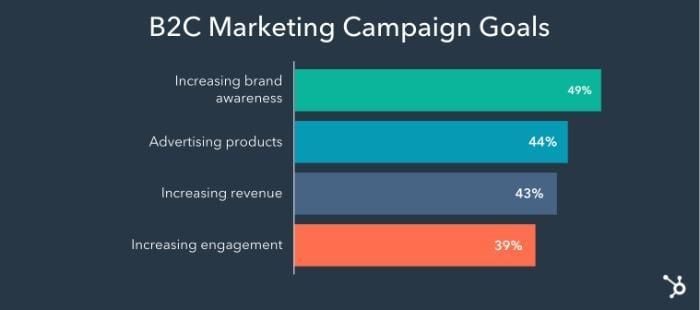
- Increasing brand awareness and revenue
- Improved engagement
- Advertising products
Let's start with the fact that one of the top priorities for B2C content creators is better engagement; Increased brand awareness and revenues are also up there as the main aims of today's marketers.
We must now ask ourselves, why are those are the top priorities?
Why do people want to create more engaging content, and why do they want to improve brand awareness and revenues?
Most likely, it's because these companies aren't totally satisfied with their current content marketing efforts. Regardless of the results they're getting, they probably think they could do even better, and they're probably right, certainly when it comes to revenues.
Parse.ly's State of Content Marketing 2022 report shows that 53 percent don't tie revenues to their content, while 20 percent don't know if they do or not!
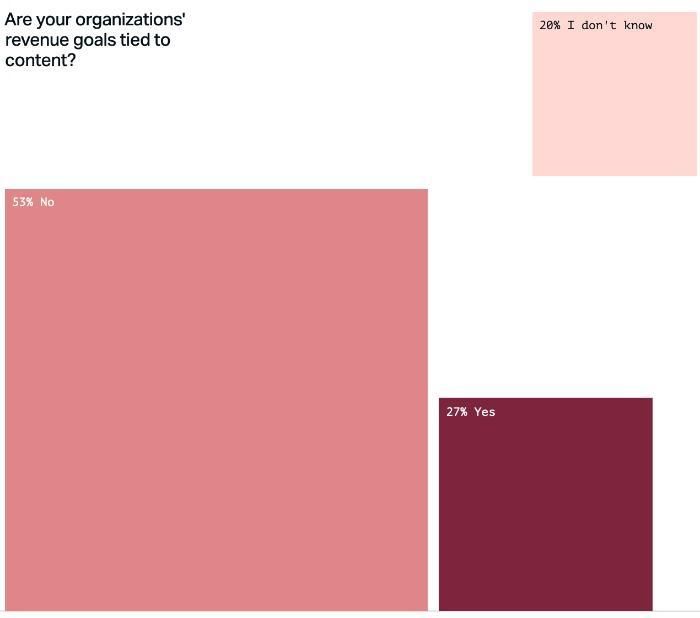
The survey also reveals that 49 percent of marketers interviewed don't know how their content is performing because they fail to track it. The takeaway from these two findings? Parse.ly concludes:
"If you don't know how your content is performing, all the way from creating awareness to generating ROI, how can you set and ultimately achieve revenue goals with content?"
It's easy to understand why engaging readers and brand awareness are among the main concerns of marketers. After all, if you can't engage your current customers or prospects, you've got little chance of converting them into buyers or developing leads.
Then there's brand awareness.
Without that, your business won't go far. If people aren't aware of your company and what it does, then they can't find you among your competitors.
Arguably, though, the biggest challenge is content marketing itself. The rush to create engaging content that retains and brings in fresh customers is incredibly competitive. People are trying to create more and more content every year because great, mediocre, and terrible blog posts, videos, and infographics are increasingly cluttering the online environment.
What do you do about the content overload challenge?
Well, you could use that clutter as an excuse to not create content for your business. Alternatively, you could take it as a sign that content marketing is well worth your time. You just have to invest more energy into it to stand apart from the crowd.
However, it's important you remember this: Even though many businesses are struggling with their content creation, many also understand the current power of their strategies.
After all, just because those businesses are dissatisfied, it doesn't mean that their content marketing efforts are falling dead. It might just mean that those businesses have extraordinarily high standards for success, or they're not outshining the competition.
As I've explained, the content marketing world is more competitive than ever before. Every time you Google something, you get millions and millions of results, yet, you only see the top SERPs.
That means that searches are only seeing a few people for that keyword.
You, of course, get to decide if content marketing is a fit for your business. However, I hope you can see that it's a fit for almost every business.
Whether you're a tractor company, a coffee house, or a blender manufacturer, there's a content marketing strategy that can benefit your ROI, but can you stand above all of the online noise?
That's what we're going to talk about next.
Content Mapping Based on the Customer Journey
Have you heard of content mapping before?
If you haven't, it's about time to learn, as it's remarkably valuable to your own content marketing strategy.
Content mapping is the act of understanding your audience so well that you can then create content for each stage of their journey toward buying your product.
As you well know, few people go straight from discovery to buying.
Instead, they usually discover your website, think about your product, spend a few months thinking, see a retargeting ad, and then buy.
At least, it goes something like that.
The point is that people take a lot of time to buy, and according to HubSpot's State of Inbound Marketing 2022 report, 60 percent of marketers consider content marketing as either 'very important' or 'extremely important' to their overall strategies.
Indeed, content marketing meets prospects at every stage of their customer journey, attracting, engaging, delighting, and gently nurturing them until they become a buyer, and hopefully, a loyal customer.
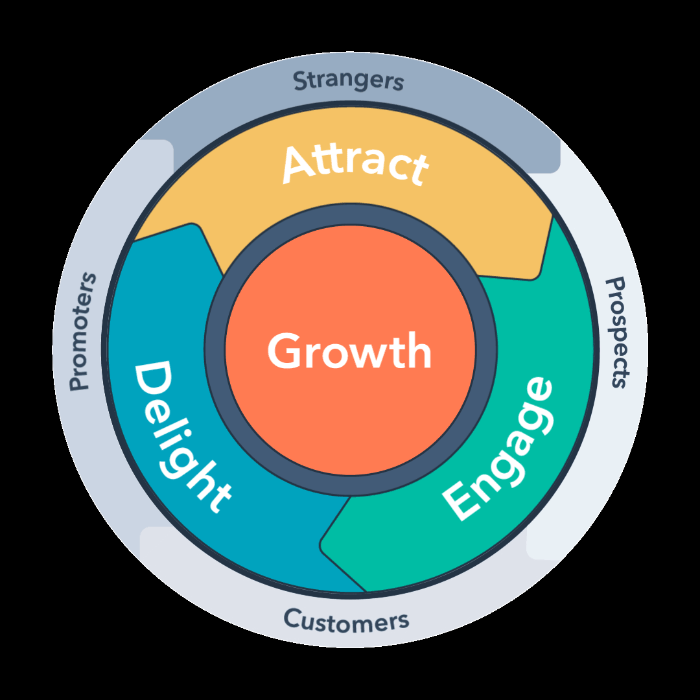
Further, if you get it right, these loyal customers then become evangelists for your brand, spreading the word about your product/services among friends/family, social media, and other formats.
Think about it.
People see your content, and then they know who you are. However, if they don't join your email list or opt into something, then you don't know who they are.
That further means that you have no way to track how many people actually bought your product because they learned about your business from the content you created.
For that reason, the effectiveness of content marketing can be a bit ambiguous.
In a perfect world, your content marketing strategy would guide people like this.
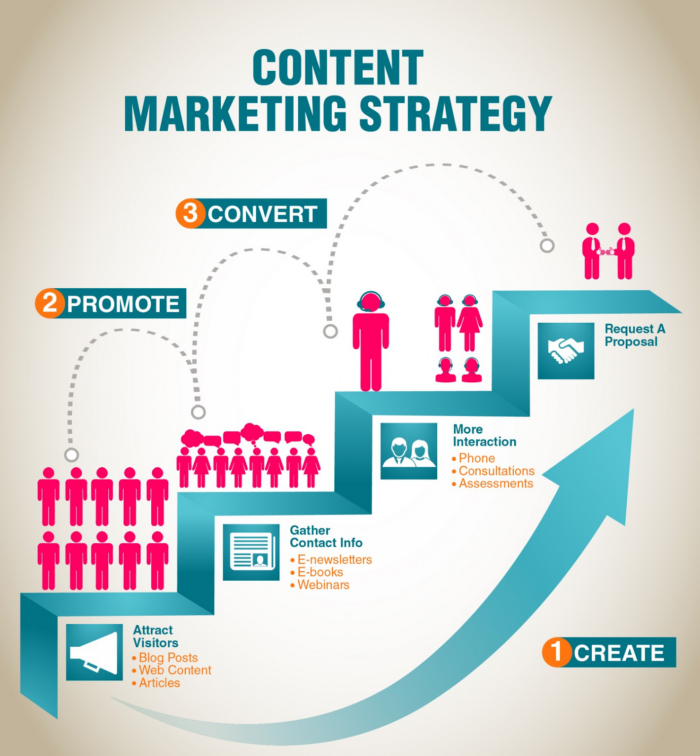
However, you know as well I do that we don't live in a perfect world.
We live in a world where everyone is a bit different, and the real reason that someone buys a product is often quite fleeting.
Did they buy because of the advertisement they saw or because of the article they read a week before?
It's hard to tell.
Of course, we marketers can still work with what we have at our disposal. That ambiguity isn't an excuse to ignore the identity of our customers.
Still, the better we know our customers, the more effective our content marketing strategy ends up being.
One of the best ways to do that is by creating a customer avatar. It should look something like this.
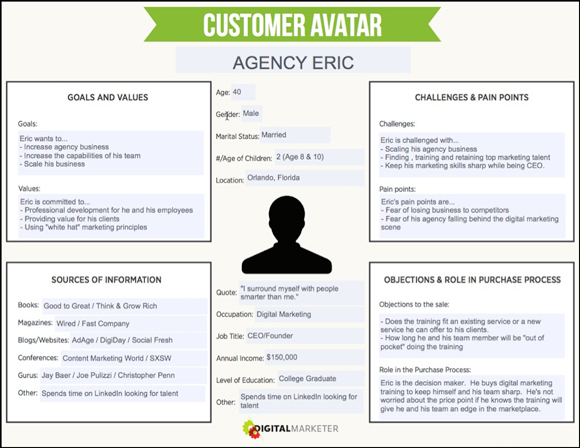
When you do that, be sure to be specific. You want to pretend that your entire audience is a single person with individual desires, goals, pains, and demographics.
Then, and only then, can your content do a far better job of talking to the people who matter.
You can't do that if you don't start by understanding who your ideal customer is.
The better that you understand your customers, the better you can make their buying journey from traffic to prospect to sale, and that can directly impact your revenue.
Why? Because of the enhanced customer experience (CX).
The effects of an exemplary CX are indisputable. Look at any survey, past or present, and they show you what providing the best possible experience for your buyers can do for your business.
Let's look at this survey from Usersnap.com. Its State of CX Report shows that:
Companies with a CX vision in place are predicting 9 percent growth year on year(YoY). That's compared with businesses without a CX vision, who are expecting just 3 percent growth.
The survey also highlights how organizations clearly understand the importance of CX, as 76 percent of those surveyed had 'CX initiatives in the pipeline.'
However, here are two figures you want to pay the most attention to:
- 84 percent of companies surveyed say a better customer experience improved their revenues
- 80 percent of consumers say they're more likely to buy from businesses that offer a personalized service.
The results of this survey are easy to understand: if you guide your prospects through the buying journey with helpfulness, kindness, and availability, they are much more likely to love you, and when people love you, they tell their friends about you.
The point is that your customers want a remarkable experience, and your content marketing efforts can give that to them. However, you must know the way that people buy and then create content for each stage.
There are three basic stages:
- Awareness
- Consideration
- Decision
As I explain in the next section, each stage requires a different kind of content marketing.
Awareness Stage For Content Marketing
The first stage of a buyer's journey is awareness.
They simply become aware of your business. They aren't necessarily ready to buy yet or even ready to opt-in to your email list or newsletter. However, because of the content you created, they are familiar with you.
Why is that valuable to your business?
Naturally, if people don't know who you are, they can't join your audience or, most importantly, buy from you.
People must first learn about your business and content marketing is perhaps your best ally for that.
For example, I conducted a search for "How to write a great blog post" on Google. This is what came up.
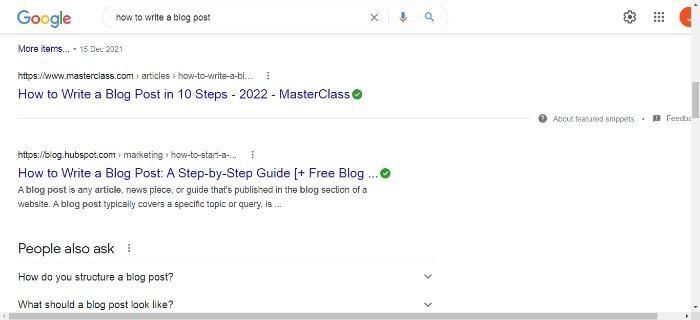
Which result would you click on? That's right: the big Google snippet from HubSpot.
Alternatively, and forgive me for the self-promotion, but you might even click this post about how to write a killer blog post in under 60 minutes:
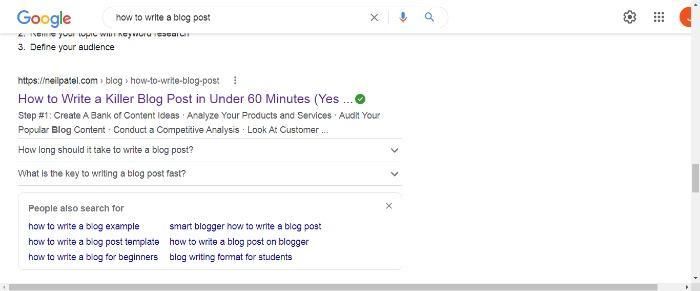
This shows you how powerful content marketing and SEO together can be for building brand awareness. Now, I don't have to preach to you about how many people use Google to search or how many of them prefer to click on organic results instead of paid ones.
The reality is that people search like crazy. If you're the one coming up on the SERP, then they see your brand name repeatedly.
Ideally, then, once they click through to your website and the content itself continues to impress them.
For instance, I went ahead and clicked on the HubSpot result to see what their blog post looked like.

It seems like they thought of everything. They offer free blog post templates and even a reading time estimate.
Both of those details help to flatter the person who arrives on the page.
You want to do the same thing.
After all, the last thing you want is to gain a great SERP position and then lose that position because of a high bounce rate.
Take a little extra time to create great content before publishing it.
How, though, do you measure what great content is?
Regarding brand awareness, pay attention to the most important content marketing metrics. These include measuring:
- users, page views, and unique views to understand brand awareness
- click-through rates, bounce rates, social shares, comments, social mentions, time on site, and inbound links, to analyze engagement
- page and domain authority for SEO
- click-through rates and conversions, to see conversions
- Demo requests, sales conversion rate, and sales cycle length, for understanding sales enablement metrics.
When you have a clear measuring stick, like those detailed above, it helps you make sure you're investing in the top-level things that matter.
You can, for instance, figure out which blog posts are performing the best and try to replicate that. By using the same metrics, you can also find out which blog posts are not performing well and then figure out what went wrong.
The point is that the more you measure your successes and failures, the quicker you'll have a top-of-funnel content marketing strategy that actually works to build brand awareness.
SEO is one great way to do that, but, of course, content marketing is vast, and SEO is only the tip of the iceberg.
Social media content is another great way to build brand awareness, for example.
Since most people access their accounts every day or every week, the chances of people seeing your posts skyrocket.
That's true even if you only post three or four times a week.
That simple feat will work wonders for building your brand awareness.
That's exactly why massive retail brands like Dove use the platform to spread brand awareness and engage their audience.
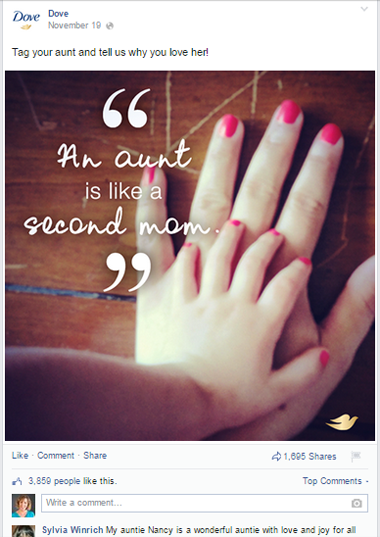
Just remember that people don't go onto social media platforms because they want to see your posts and buy your products (unless we're talking about Pinterest).
For that reason, don't get too sales-y.
Ideally, you want to spread your brand message and strengthen your brand identity without being too pushy about it.
Most people on social media are simply looking for entertainment.
Offer that entertainment, and people will appreciate your business and be more likely to buy from you in the future.
Oreo is another company that uses social media to spread its message. And since they are a big enough brand with a strong enough message, they can afford to be a bit more sales-y.
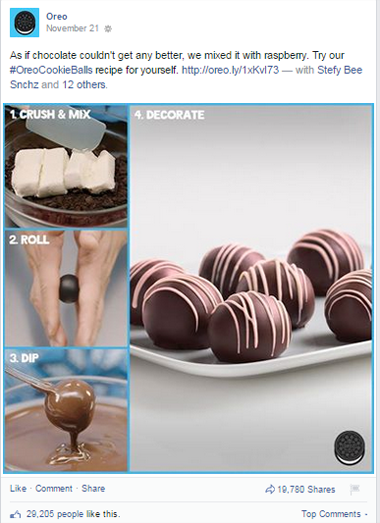
In other words, once your brand image is strong and people know who you are, they mind less when you talk about your products.
At first, however, you must prove to your audience that you care about them.
Only once they know that you genuinely care about them will they listen to your discounts, deals, and offers.
You have to focus on your brand image first and your sales second.
Social media is incredibly powerful.
And every marketer knows it.
If you want to start building brand awareness for your business, focus your energy on SEO and social media.
People see you, they learn to trust you, and, most importantly, they'll probably buy from you later on.
Consideration Stage For Content Marketing
Once people become aware of your business, they buy from you, right?
If only it worked like that, but, of course, it doesn't.
Truthfully, people have to hear about you, take time to get to know you, and then maybe they buy something from you.
You see, content marketing is remarkable at alerting people to the fact that your business exists, and it's every bit as good at guiding people through the consideration phase.
Ask any great salesperson and they'll tell you this: people are far more likely to buy when you guide them through the process.
However, you can't, or rather shouldn't, use the same brand awareness tactics during the consideration phase.
In particular, pay special attention to newsletter sign-ups, number of returning visitors, form submissions, and resource downloads.
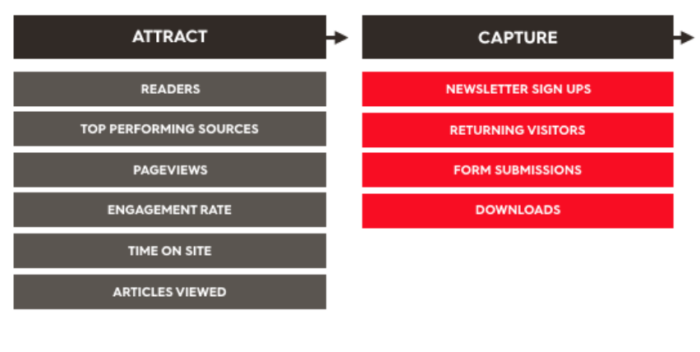
Basically, you're trying to gauge the interest of your current prospects.
To do that, though, you first must create content to continue attracting people who are interested in your products.
Content like e-books, for instance, does a remarkable job of building trust during the consideration phase. Why does an e-book do such a fantastic job at this stage?
Well, before people buy from you, they must trust you. As a consumer, you understand that yourself. You wouldn't buy from a brand you haven't heard of, would you? Nor would you buy from a company if it had a reputation for delivering shoddy goods or poor customer service.
Customer trust is imperative to every business, and research supports this. For example, a study from Adobe shows seventy percent of those surveyed buy more from brands they trust than ones they don't.
It's clear: trust spurs spending, and consumer trust is all-important, especially with e-commerce dominating retail, meaning many buyers never get to interact personally with sellers.
To gain trust, your prospect must become familiar with your stance on certain topics, your brand image, and even the tone of your business's voice.
Only then can someone decide whether they trust you or not.
That's why an e-book gives people something to latch onto. They can read about your stance on certain topics, grasp your tone of voice, and how you present information.
Is the information reputable, for instance? If it is, then people can also believe that your business is trustworthy.
If it's not, then they attribute that same carelessness to your business.
A newsletter is also a great way to generate trust during the consideration phase of the buyer's journey.
A consistent newsletter creates a sort of ongoing conversation with your prospects.
They might not be ready to buy yet, but if they sign-up for your email list, then they are likely considering it.
If you can stay in contact with prospects during the consideration phase, then you have a far better chance of converting those people.
A newsletter does that with finesse.
Different entrepreneurs and business people use newsletters to stay in constant contact with their prospects.
That way, their business is top-of-mind when the person is ready to buy.
Of course, SEO also works for the consideration phase, but it's a different kind of SEO.
Long-tail keywords, in particular, focus on people who are in the consideration phase more than their shorter counterparts.
Think about it.
If you're really interested in a product from a business, then you'll search for something like "Buy shoes from Adidas" rather than "Shoes for sale."
Plus, those long-tail keywords are less competitive, so you have a higher chance of ranking for them.
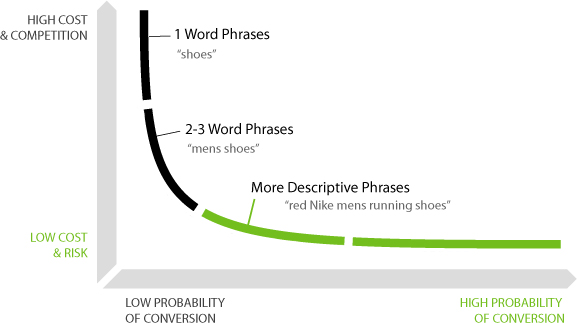
To recap for the consideration phase, focus on long-tail SEO keywords, newsletters, and e-books.
During this stage, you could also use blog posts, infographics, case studies, or even videos.
With those, you can guide people through the consideration phase rather than leaving them to their own devices.
In the end, you want to create content that builds trust and builds the prospect's relationship with your business without being too sales-y.
At least, that's your approach until those people reach the decision stage of the buying process.
Decision Stage For Content Marketing
This is your favorite part of the buying process, because it's when people take that extra step and purchase.
The decision phase is the point in the buyer's journey where they've made a decision to buy your product or service.
You already have their trust, and they are familiar with your products and what you stand for.
Now, it's the time to make or break, push or shove, buy or ditch.
The person is either going to become a paying customer or fall into eternal obscurity.
This is the place where your opportunity pipeline, average size of orders, order frequency, and sales come into play.
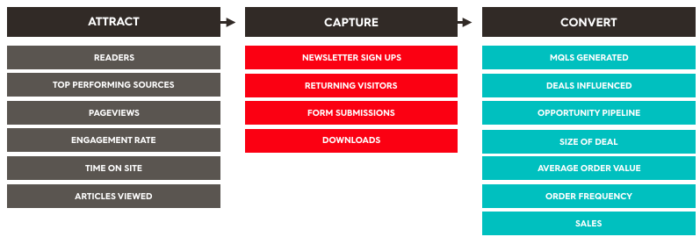
To put it another way, it's conversion optimization time in terms of your content marketing efforts.
Do you know what that means? It's time to target long-tail keywords in your content marketing strategy. This is because, in general, the longer the keyword, the more likely someone is to buy from you.
When your prospects is using more specific, longer keywords, then typically, they're at the buying stage, and when you include your brand name in long-tail keywords, that's even better.
Why? You've probably guessed it, but people including brand names in their search want to buy from them,
Just consider this keyword: 'how to start an e-commerce store.'
What's the first result you see?
It's from Shopify.
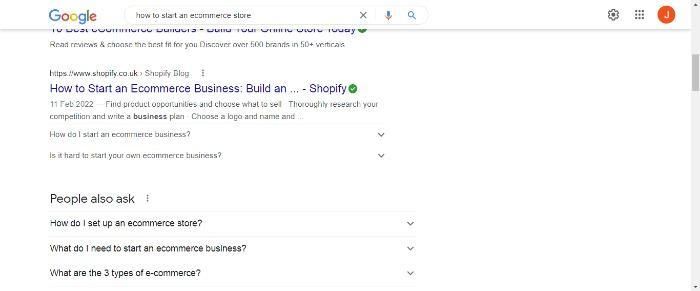
If you know anything about Shopify, then you know that it's an e-commerce platform where beginners and experts alike build their online stores.
For Shopify, then, they do well to appear for that search.
The people who type in that keyword are most likely ready to take the next step in their buying journey.
You just need to convince them that your business offers the best solution.
Shopify doesn't let up when they try to convince visitors that they are that best option.
I clicked on that result and glanced through their blog post.
The first thing I noticed is that Shopify has CTAs throughout its content, like these:
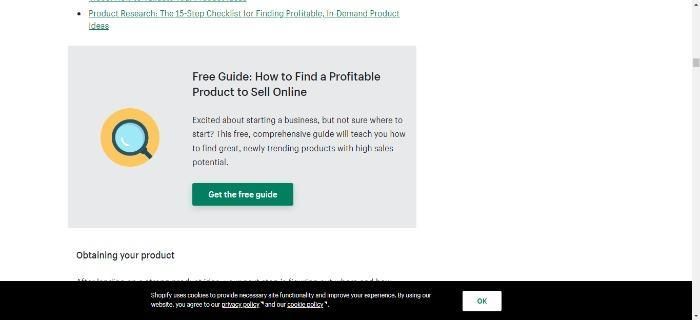
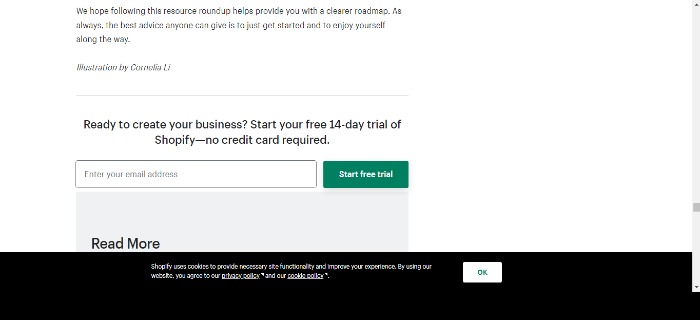
Would these CTA's work for all types of content? Probably not.
In content that caters to people who are simply in the awareness or consideration stages of the buying journey, for instance, those CTAs would probably come off as too pushy.
However, in this content that is supposed to cater to people who are ready to buy, the CTAs are perfect.
You want to strike the same chord that Shopify does.
Use your blog to create content that caters to long-tail, high-commitment keywords and then include compelling CTAs within that content.
Remember: these people are ready to buy. You just have to give them a little push.
Consider offering a discount, free trial, or special offer to do that.
Additional Forms of Content Marketing
Now that you understand what makes content marketing powerful and how you can use it to map out your customer's journey from awareness to conversion, let's talk about a few additional types of content.
I've briefly mentioned some of these already, but they are worth mentioning in a bit more depth.
Social Media
Social media is one of the most effective tools for content marketing. It allows you to share your content with a large audience quickly and easily.
In addition, social media provides an opportunity to connect with potential customers and build relationships with them.
It gives free access to a massive amount of people within any target market, and if you decide to run advertisements, you can choose where to show your face.
You won't be alone if you jump on the social media advertising bandwagon. Ever since social media became a 'thing,' marketers have targeted social media in their droves since they realized its role in selling their products and reaching their ideal customers.
Innocent Drinks is just one example of a company that's using social media to its advantage.
In particular, it uses social media to strengthen its brand image as a funny and enjoyable business.
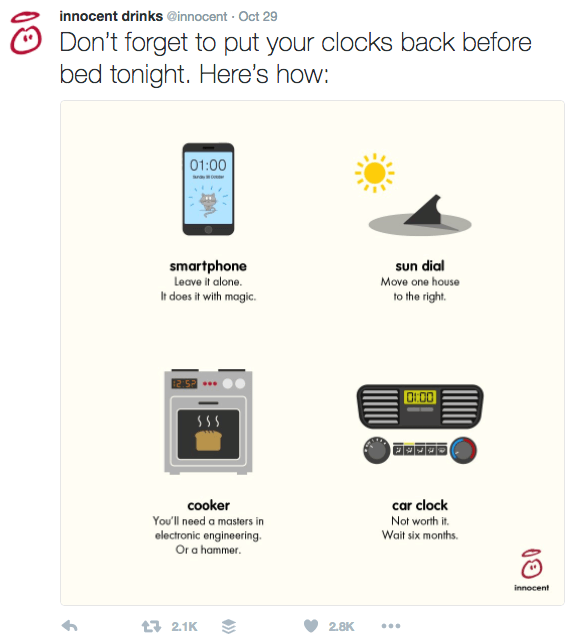
In other words, Innocent entertains its audience before expecting those people to buy.
Why do they do that, though?
Is that really a powerful marketing strategy? Does it actually work?
The short answer is yes, it does.
It's simple. Businesses with a connection with their customers are more likely to sell to them, and if you can provoke emotion, and make consumers laugh, cry, or share, there's an even better chance they're going to buy from you.
Here's another post from Innocent that surely got a few laughs.

And here's one more that will literally make you laugh out loud.
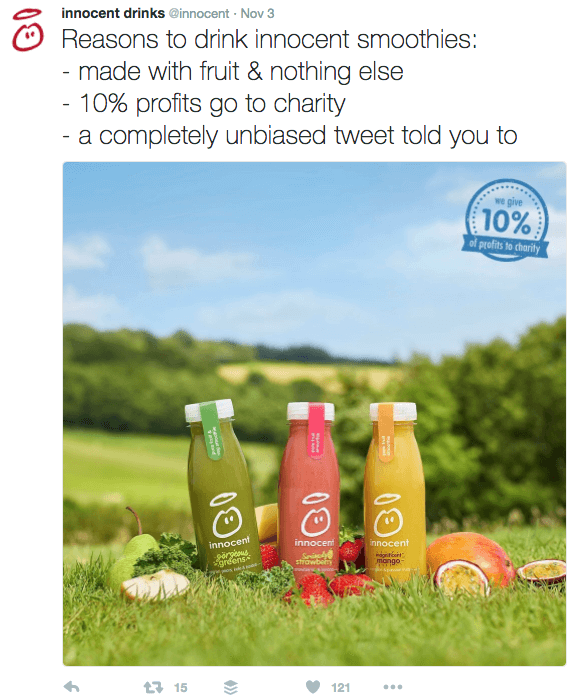
But, of course, Innocent is a notoriously silly brand. They've spent a long time building up their brand image that way.
And why not?
They sell juice. They really have nothing else to do but make people laugh, right? You, though, might not have that luxury.
Maybe you sell more formal products or find yourself more in the B2B marketing space.
Well, you can also use social media to entertain people and build your brand image.
Are you having trouble believing me?
Check out this example from Staples.

Staples uses its social media platform to have a good time with its customers. And that's because the better experience you offer your customers, the more money those people will spend.
Here's another post from Staples.

What's the point?
Social media excels at promoting brands because it promotes relationships.
You can grow an organic following, drive traffic, and even encourage sales.
Once you have an audience of your own, then marketing to that audience over and over again becomes easier and cheaper than ever before.
But remember: they follow you because they like your content, not just your products.
So spend a little time entertaining them, and they'll pay you back in cold, hard cash.
Live Video For Content Marketing
What if you could communicate with your audience over video in real time without using Skype or Google Hangouts or similar tools?
Oh, wait. You can.
It's called live video.
Thanks to Facebook and smartphones, live video is now easier to use than ever before, and I shouldn't have to tell you about how powerful video content marketing is. It might be because video:
- gives extra transparency
- highly visual
- or because people like seeing your face and making human connections
Whatever the case, people love video, and you can use that to your advantage.
According to Wyzowl's State of Video Marketing Survey:
- 86 percent of marketers surveyed use video as a marketing tool.
- 94 percent say video improves customers' understanding of its products/services
- 81 percent of marketers feel that video marketing has a positive impact on sales
- 92 percent of marketers consider video an important part of their marketing strategy
Today, with the ability to seamlessly edit videos using solutions like InVideo, the chance of succeeding with your video marketing is now easier than ever before. If that doesn't convince you, nothing will.
However, there's one thing more powerful than video: Live video.
Grandview Research predicts that by 2030, the video streaming market size will reach $330.51 billion, and people just love to tune in.
According to HubSpot, 57 percent of the consumers surveyed watch live videos three times a week, and their favorite platforms to view them? Yes, you probably guessed it, social media, with YouTube, Facebook, and Instagram being the favorites.
Why this big love for live streaming?
Most likely, it's transparency. They might make a mistake, they can't edit the video, and the viewer gets to see who the person really is. In other words, it's authentic, and that's what today's consumers crave.
To round off this section, here's a quick tip: If you want to build a strong relationship with your audience, then consider running weekly live videos; do them at the same time every week so that people know when to hop on social media and tune in.
Paid Advertising and Content Marketing
Content marketing is primarily an inbound marketing tactic. However, as with most marketing tactics, the lines are blurry somewhere in between inbound and outbound.
That's because you can still create content and then drive traffic to it through advertisements.
Consider this ad from Grant Cardone, for instance, where he markets his business certifications and classes.
Basically, it's just a glorified piece of content that costs money.
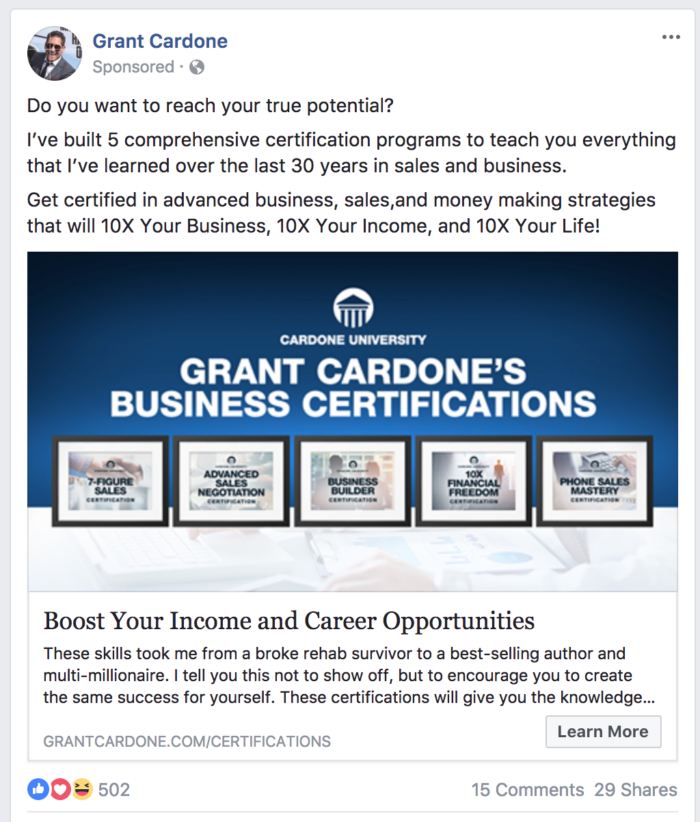
It's inbound content meeting outbound marketing.
And it's a great way to attract people to your website.
Now, you might be wondering why you would do something like that (especially if you're giving away the content for free).
Why would you pay to drive people to your website who aren't going to pay you in return?
Well, the answer is quite simple.
If you're a new business with a small audience, then you might need to give your audience growth a boost by running advertisements for some of your more remarkable content.
If you don't want to wait to grow an audience organically, then you can drive traffic to your content with paid advertisements.
Here's another example of Shopify doing that.
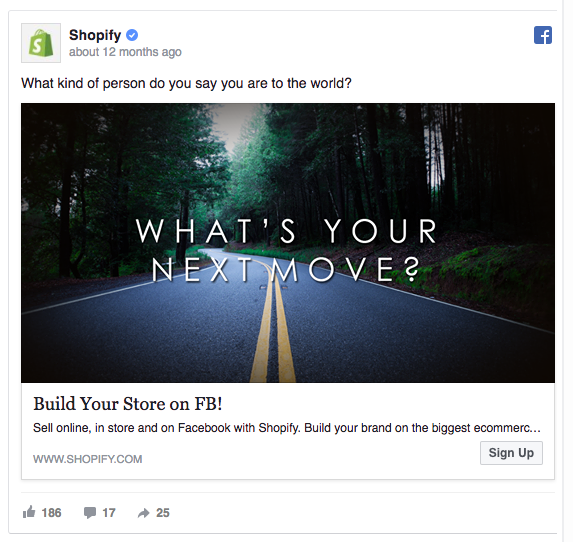
Of course, Facebook isn't the only place you can use that content marketing strategy.
You can do the same thing with Google Ads.
Just consider this advertisement that drives traffic to an actual piece of helpful content rather than a landing page.
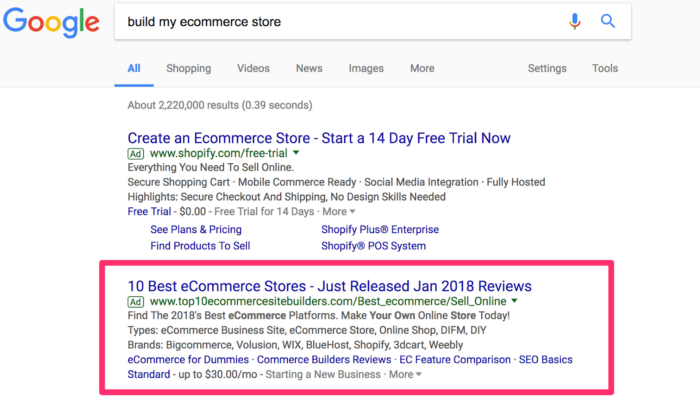
Of course, you can also just drive people straight to your landing page like these advertisements for baby clothes.
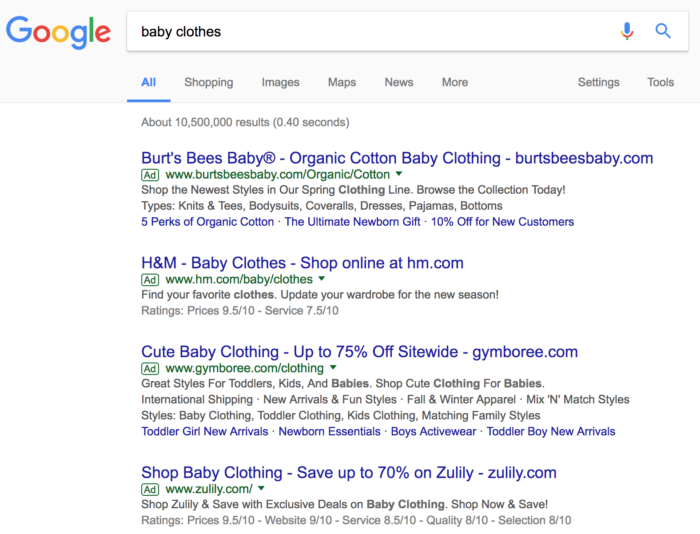
However you try to do it, it all truthfully involves content creation.
Even an advertisement, in a way, is a piece of content.
And paid advertisements are a great way to boost your traffic and sales if you're in the beginning days of your business.
The first days are often the hardest. But with paid advertising, they don't have to be.
A Few Extra Content Marketing Tips and Tricks
Before we dive into a ton of offline and online content marketing examples, I want to quickly show you a few necessary tips for your content marketing strategy.
Use Analytics
The first tip I have for you is to always pay attention to your analytics; they tell you what's working and what isn't, so you can tweak your strategy and optimize results.
If you don't know how your current content is performing, then you won't be able to prevent blunders and iterate what's working well.
Google Analytics will give you all of the necessary information.
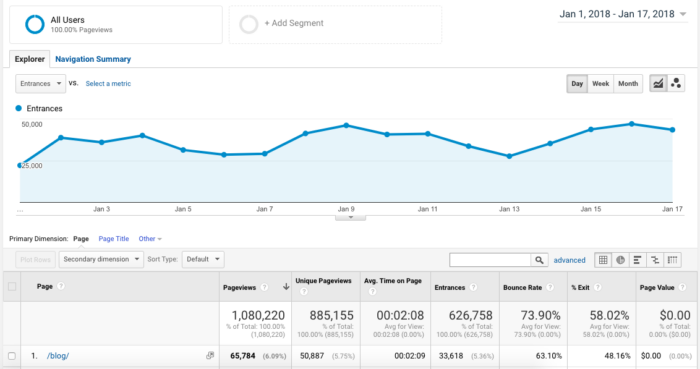
For an even better understanding of your stats and new features, find out what you can about Google's new standard, Google Analytics 4. On July 1, 2023, Universal Analytics is getting sunset, and GA4 will be the only game in town.
- Records website and app data for a clearer picture of the customer journey
- It comes with privacy controls, including cookieless measurement
- Integrates with media platforms
- Includes predictive capabilities.
To learn more about GA4, visit Google's answer page, where you can also learn how to start.
Use A/B Testing
Once you know how all of your content is performing, run tests. In particular, you can run A/B tests, which are remarkably powerful. A/B testing is a way to test two pieces of content that are identical except for one factor. Maybe it's the copy. Maybe it's the CTA. Maybe it's the title.
Whatever the case, A/B testing removes all the factors except for the one you want to examine, giving your test far more accurate results, and it's a great way to gather the information you need to iterate your current content marketing strategy.
Organize Your Content Schedule
As content marketers and creators, we're often disorganized, but that hurts your consistency and overall effectiveness. However, it's easy to get back on track.
Use a tool like CoSchedule to keep your content calendar in one cohesive location.

With an organized content schedule, helpful analytics, and regular A/B testing, your content marketing efforts have a better chance of success.
After all, if you're spending the time and budget on content marketing, you should make the most of it.
To further help you do that, now we're going to look at over some offline and online content marketing examples that will inspire your own strategy.
Let's get started.
Offline Content Marketing
While the comic book industry is even more on fire today, that isn't the case for all the offline channels where brands used to tell stories, but we can translate all of the lessons that we learned from them today in one way or another. Here are some examples:
Offline Example #1: Ad Supported Tiers for Streaming Services
HBO Max, Paramount+, and Discovery+ are just some of the top streaming services available today. However, we all know who dominates the streaming sector: Netflix.
OK, so Netflix is losing subscribers, but it's got a plan to turn things around. That said, there's no denying Netflix's past success, and content marketing is at the forefront of that.
If you search for stellar examples of marketing, Netflix often features among the top picks. Why?
Here's an example.
To spread the word offline, Netflix often takes its most engaging shows and creates experiences around them. For instance, Netflix launched a series of billboards and murals for its hugely popular 'Money Heist' show, along with experiences so people can become part of the 'heist'.
Additionally, Netflix advertises its 'originals' shows to new audiences in outside locations and through ambient marketing; this involves placing adverts in unlikely, but unobtrusive places, and carefully placed outdoor banners.
Most importantly, Netflix's offline advertising strategy is cohesive, working alongside its online content marketing, as part of a multi-channel approach.
Offline example #2: From Sneaky Advertising Tricks to Viral Commercials
When Hasbro released the G.I. Joe comic book series, it faced a dilemma.
Hasbro wanted to run TV commercials to promote its action figure toys and comic books, which was a new concept.
However, TV regulations stated that toy commercials had to show the toys and could only include up to ten seconds of animation to not mislead kids into thinking the toys could do more than they did.
Hasbro circumvented this problem, by focusing on the story, not the product: it completely took out the toys and just promoted the comic book series.
Never before had a TV commercial solely promoted comics, and, thanks to bending the rules, Hasbro could show 30 fully animated seconds of material.
The original commercial even made it to YouTube.
However, back then, TV commercials themselves were still working. In today's advertising world, where our attention spans have shrunk to that of a goldfish, TV ads hardly capture us anymore.
What does spark our attention are viral commercials like the ones for the Super Bowl. Take the most recent Super Bowl as an example.
Any guesses which commercial got the most views from this year's Super Bowl? It was the Amazon 'Mind Reader' ad.
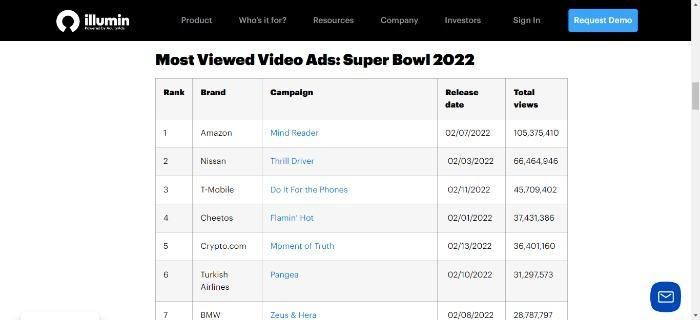
In case you haven't seen it, the commercial stars real-life star couple Scarlett Johansson and Colin Jost and depicts what may happen if Alexa could read minds and say what we are really thinking.
Throughout the ad, the celebs make fun of their married life, and as you might expect, there's a mix of scenes: embarrassing, funny, and squirm-inducing.
The commercial not only attracted millions of viewers during the Super Bowl itself but it's also become a viral video garnering hundreds of thousands of views and social media shares.
Here's the best part: It continues to do so. Every Super Bowl commercial Amazon creates becomes an online asset and collects views for years to come.
Customers are happy because they can spend hours entertaining themselves, and Amazon is happy because it nurtures the relationship with its target audience while the executives are sleeping.
Online Content Marketing
OK, so offline translates to online one way or another, but hasn't content marketing really been all about the interwebs from the beginning?
Yup, it has.
Brands are huge on it, and some do a pretty good job, and that's why it's time to look at some of the best examples of content marketing that originated online.
Online example #1: The First Viral Video Ever
Back in 2005, when Google Video was still Google Video and when people used to download videos to watch them offline, the first viral video came out.
The IT company LiveVault hired two independent marketers who decided to make an entertaining video that would stand out among IT professionals, who were their target audience.
After all, disk-based backup systems for corporate data were not very sexy, so they decided to go for a few laughs.
Famous actor and comedian John Cleese made sure that they got them.
Cleese demonstrates the severe consequences of a fictional disease called "Backup Trauma" and leaves the viewer with several options to continue exploring the company's products and services by clicking buttons at the end of the video.
It was great content because it was funny and interactive, yet it still promoted their services.
Internet users downloaded the video almost 300,000 times in the first few months after its release, and remember, this was over a decade ago!
Of course, with so many people publishing so many videos daily, it's gotten harder to stand out, but, if you create high-quality video content, you can still land a hit!
Online Example #2: WordStream
Even if you're relatively new to marketing, I'm sure you're familiar with the term 'lead magnet.' If you're not, it basically means creating an irresistible offer that your target market can't wait to download in the form of an eBook, cheatsheet, or another freebie.
Typically, these are products the website team creates and then uses to get prospects to part with their contact details, like their email address, so they can continue to nurture the lead until they become a buyer.
There are numerous examples I could cite here, but I'll go with WordStream.
The site offers several freebies, including a cheatsheet including 120 emotional words and phrases to help you create compelling content.
When you visit the site and stick around for a moment, this is what you see:
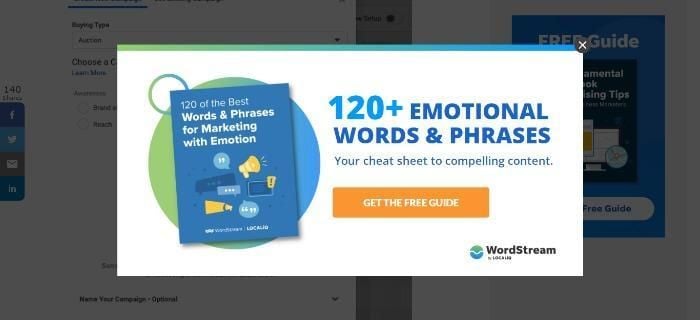
Sounds good, huh?
The site also provides in-context freebies. For example, if I'm reading an article about Facebook ads, then alongside it, WordStream offers a free '7 Fundamental Facebook Advertising Tips for Small Business Marketers'.
These freebies are two great pieces of content marketing.
There's one targeted at any marketer who wants to write more compelling content (which is just about all of them), and another lead magnet aimed at small business marketers who what some tips for writing Facebook ads, for a more niche audience.
That's a simple content marketing strategy that any website owner can adopt, which is what makes it so good.
Online Example #3: Podcasts
Podcasts are the radio of the 21st century, and they're a potent content marketing tool.
With podcasts, there is just less advertising and more value. Most podcasts have a sponsor or advertise a product at the beginning and the end of the show, but that's it.
People love them because they can listen to their idols and heroes spill their guts about whatever topic they're interested in
For example, if I listen to Nick Loper's Side Hustle Nation podcast, I deepen my relationship with both Nick Loper as the host and the interviewee, who's usually a hugely successful entrepreneur, making big money from a side hustle.
It works because I get to know more about them, and since they're motivating and inspiring me, while giving tips I could put into action, I'm happy to turn to them in the future for further advice.
Online Example #4: Guides and E-books
Think through this scenario with me.
You've done what few people do and have created an actual product for your online business.
You've created a sales page and sent it around, but no one buys.
There's something missing. Then, it hits you.
You need to learn copywriting.
That's easy enough. You just turn to Google, right?
Well, as an experiment, I typed in 'learn copywriting' and Copyblogger showed up among the top results.
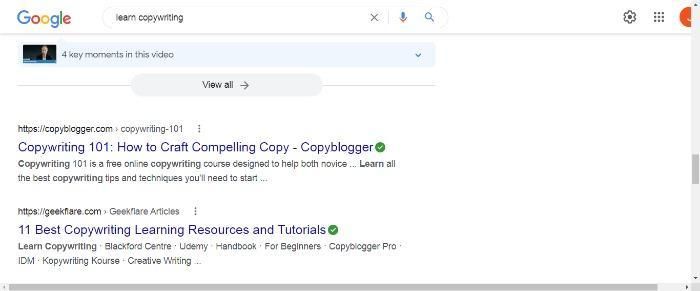
Now, I could've gone with any one of the ads, but I chose Copyblogger because I know exactly what I'm going to get. The copy tells me I'll receive a free online copywriting course, and from the headline, I see that it teaches me how to write compelling copy. What's not to like?!
Then I click on the ad and it takes me to a simple, one-line sign-up form, which makes subscribing a no-brainer; the page also features a ton of resources I can click through to if I want to learn some of the finer points of copywriting.
From these resources, you could learn the fundamentals of copywriting in a short period, and if you want to learn more, it's highly likely that Copyblogger would be your first stop.
Online Example #5: Red Bull Stratos
This one's remarkable. It's like Red Bull created its own mini version of the Super Bowl.
On October 14, 2012, Felix Baumgartner, the Austrian skydiver, jumped out of a hot air balloon floating in the stratosphere. He basically jumped toward the Earth from space.
He fell down 24 miles at 843 mph. He broke Mach 1 and 3 while simultaneously breaking three world records: the first human to break Mach 1 without any engineered vehicle, world's highest balloon travel, and highest jump.
Never has anyone done this before.
And who was the sole sponsor of the event? It was Red Bull.
They made history – and marketed it.
Not only did the event get insane media coverage and buckets of social media activity, but it also went into the Guinness Book of World Records for the first freefall to break the sound barrier.
It was full of excitement and gripping suspense. It was entertainment at its best. And needless to say, it was a total home run for Red Bull.
Online example #6: GoPro's Sponsorships
"Hey, when you surf that next huge wave, want to film it? Here's a camera that's perfect for doing so!"
GoPro is wherever sports are, which is pretty much everywhere.
Considering GoPro is a tool for creating visual content, showing how great it is at what it does, is the best way to market it.
Therefore, they sponsor all kinds of events, athletes, and artists like surfers, bike racers, and even Rubiks' cube jugglers.
GoPro's marketing strategy is to hand people cameras and let them do what they do, then the product basically markets itself.
All GoPro has to do is edit the video and throw some cool music on top of it, and they get millions and millions of views. At the time of writing, its attracted 50 million views and counting.
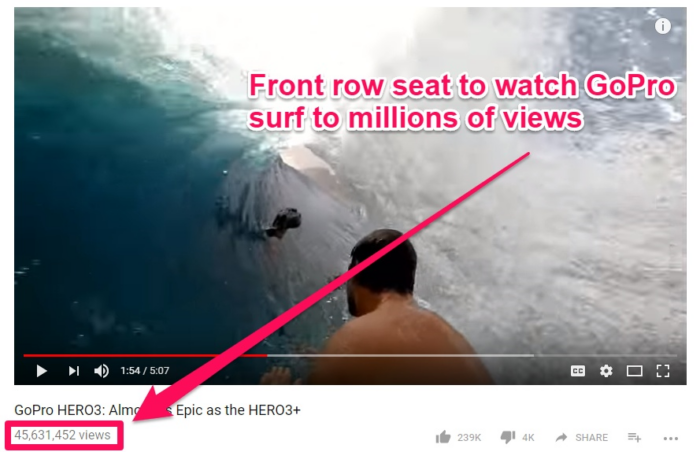
I don't know how many times I watched that video, but I'm sure you can guess what camera I bought when I went to Mexico on a vacation with friends.
Content Marketing Hybrids
Finally, I want to show you an example of what I call hybrid content marketing. I already showed you that online translates to offline and vice versa.
Some companies already use this principle and build their content marketing strategy around that.
You can use online as a gateway to offline and the other way around.
For example, you could use social media to drive awareness to an offline event or run an offline event and take it online. Say you were a restaurant that wanted to drive a specific group of customers for a themed evening. You'd:
- Create all your online content around your chosen theme,
- Include CTAs to encourage your ideal customers to join your mailing list, so you can tell them about the event and build excitement
- Perhaps offer a discount to encourage prospects to buy tickets.
FAQs
What is Content Marketing?
Content marketing is creating content to drive more traffic and conversions from targeted audiences by answering their questions and addressing their pain points.
What Types of Content Marketing Are There?
E-books, blog posts, articles, white papers, social media, paid ads, billboards, and so much more.
What Are the Stages of The Content Marketing Purchasing Funnel?
Awareness, consideration, conversion, and loyalty.
Conclusion
Phew! That was a lot of examples, and there are countless more examples of content marketing out there.
They should give you a good idea of what it takes to be a good content marketer.
What's more, I really hope that you see that it doesn't take a huge marketing budget. On social media, we're all equal, and you don't need a huge audience, just a niche that's passionate about what you do.
The world gets noisier each day and one way to stand out is through creative content marketing that gets people talking, and sharing.
Those who focus their energy on telling good stories, no matter the platform or context, are the real winners in today's marketing world.
Yelling louder won't help you anymore. Only yelling better things will.
What's your story? Are you using content marketing already?
If you have any other great examples I've missed, please tell me about them in the comments.
Source: https://neilpatel.com/what-is-content-marketing/
0 Response to "Easy Coding Things to Do on Chrome Books to Impress Your Freinds"
Post a Comment